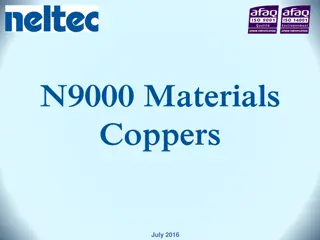Understanding Veneers and Laminates in Dentistry
Patients are increasingly seeking aesthetic treatments for anterior teeth, leading to the popularity of veneers and laminates. Veneers are tooth-colored layers applied to restore defects and discoloration, offering a less invasive and durable alternative to full crowns. The process involves applying thin porcelain or composite resin veneers to improve tooth appearance, with options for direct or indirect fabrication. Different techniques like direct composite veneers and indirect veneers cater to varying needs, highlighting the importance of proper preparation designs for preserving tooth structure and enhancing aesthetics.
Download Presentation

Please find below an Image/Link to download the presentation.
The content on the website is provided AS IS for your information and personal use only. It may not be sold, licensed, or shared on other websites without obtaining consent from the author. Download presentation by click this link. If you encounter any issues during the download, it is possible that the publisher has removed the file from their server.
E N D
Presentation Transcript
The patients demand for treatment of unaesthetic anterior teeth is growing steadily. several treatment options have been proposed to restore the aesthetic appearance of the dentition. For many years, the most predictable and durable aesthetic correction of anterior teeth has been achieved by the preparation of full crowns. However, this approach is undoubtedly most invasive with substantial removal of large amount of tooth substance and possible adverse effects on adjacent pulp and periodontal tissues. In search of more durable aesthetics VENEERS were introduced.
DEFINITION Veneer is a layer of tooth colored material that is applied to a tooth to restore a localized or generalized defect and intrinsic discoloration Sturdvent
Treatment is used to improve the appearance of a tooth, which may have been discolored/ damaged by decay / an accident. The process of applying a thin porcelain or composite resin veneer to a tooth is called LAMINATINIG Veneers could be fabricated from composite or ceramic. They could be direct or indirect.
Direct Composite veeners Indirect
Indirect technique If multiple teeth are to be veneered, indirect veneers usually can be placed much more expeditiously. Direct technique When only a few teeth are involved or when the entire facial surface is not faulty (i.e., partial veneers), cases involving young children. Time consuming and labor intensive, operator technique. Economical, single sitting procedure Composite Processed composite, feldspathic porcelain, pressed ceramic Expensive, requires two appointment sensitive to More aesthetic, less sensitive to operator technique, lasts much longer than direct veneers 6
3 BASIC PREPARATION DESIGNS Veneers with incisal overlapping with sub- gingival extension A window preparation without extension sub- gingivally or involving incisal angle Window preparation that extends to gingival crest and terminates at the facio-incisal angle
Such a preparation, preserves tooth structure, prevent significant occlusal loading and reduced potential for wear of opposing tooth. A window preparation design is recommended for most direct and indirect composite veneers. An incisal overlapping preparation is indicated when an tooth being restored needs lengthening or when an incisal defect warrants restoration.
Window Preparation Design Indications Advantages Preserves the functional lingual and incisal surfaces of maxillary anterior teeth, protecting the veneers from significant occlusal stress. Recommended for indirectly fabricated porcelain veneers in patients who exhibit a canine-guided pattern of lateral guidance. Reduces the potential for accelerated wear of the opposing tooth
ADVANTAGES DISADVANTAGES Esthetics Veneers is more conservative tooth preparation Repair potential Chair side control of the anatomy and easy polished Low thermal conductivity Less expensive Tend to discolour Wear out quickly Marginal staining Shade matching difficulty Often require repair & replacement
Indications ENDONTICALLY TREATED FRACTURED ANTERIOR TEETH DISCOLORATION DIASTEMA
TOOTH BRUSH ABRASION MISSING CENTRAL INCISOR WIDE DEFICIENT RESTORATION ON FACIAL SURFACE BONDING TO EXISTING RESTORATIONS
GENERALIZED ENAMEL HYPOPLASIA DENTAL FLUOROSIS ABRADED INCISAL REGIONS
Contraindication Highly caries index Bruxism
INSUFFICIENT FUSIBLE SUBSTRATE EXCESSIVE INTERDENTAL SPACING POOR ORAL HYGIENE EXCESSIVELY ROTATED TOOTH
TYPES OF VENEERS I. Based on the extent of tooth involved, (i) Partial veneers (ii) Full veneers - Window preparation - Butt joint incisal preparation - Incisal lapping preparation II. Based on the type of material employed, (i) Directly applied composite veneer (ii) Processed composite veneer (iii) Feldspathic porcelain veneer (iv) Pressed ceramic veneer III. Based on the mode of fabrication, (i) Direct veneers - Direct Partial veneer - Direct Full veneer (ii) Indirect veneers - No Prep veneers - Etched Porcelain veneers - Pressed Ceramic Veneers 17
TYPES OF VENEERS BASED ON SURFACE INVOLVEMENT TWO TYPES Partial veneers Full veneers Accomplished by direct or indirect technique
PARTIAL VENEER Facial view of partial veneer that does not extend sublingually or involve incisal angle
Full veneer Full veneer with window preparation design that extends to gingival crest & terminates at the facio incisal angle Full veneer with incisal-lapping preparation design extending sublingually that includes all of incisal surface.
Types of preparation Type I WINDOW preparation .(feather in which the veneer is taken up to the height of the incisal edge but the edge, is not reduced). Type II BUTT-JOINT preparation .( 2 mm incisal reduction without palatal chamfer). Type III WRAP (3 1 mm incisal reduction with 1 mm height palatal chamfer ).
Procedure for Laminate Veneers tooth preparation Involves the following steps Labial Reduction Lingual Reduction. Proximal reduction Incisal Reduction Sulcular Extension
Type I (window preparation)
Depiction of enamel thickness on the facial aspect of the tooth THE REDUCTION MUST BE IN : * Gingival third = 0.3 mm . * Middle third = 0.5 mm . * Incisal third = 0.5 mm .
1 A 016 round bur is placed at the tip of the gingival papilla and cuts the cervical margin in a counterclockwise direction. The bur shaft is held in contact with the facial aspect of the tooth A 016 round bur is placed at the tip of the gingival papilla and cuts the cervical margin in a counterclockwise direction. The bur shaft is held in contact with the facial aspect of the tooth
2 Using the 016 round bur, the gingival and interproximal margins are placed at the correct depth. Using the 016 round bur, the gingival and interproximal margins are placed at the correct depth.
3 Using the cutter depth wheels bur, make a series of different depths at various locations of the facial profile of the tooth
4 a 018 tapered diamond bur , the unprepared enamel islands are removed to the level of the horizontal depth cuts. The reduction follows the facial contour of the tooth. a 018 tapered diamond bur , the unprepared enamel islands are removed to the level of the horizontal depth cuts. The reduction follows the facial contour of the tooth.
5 It utilizes minimal tooth preparation mainly confined within enamel. Keeping clear of the gingival margins It utilizes minimal tooth preparation mainly confined within enamel. Keeping clear of the gingival margins
Type II (Butt joint preparation)
BUTT-JOINT INCISIAL DESIGN It is the simplest design and is used to easily provide adequate reduction of the tooth to accommodate the needed strength of the porcelain veneer in this area of the preparation. A butt-joint incisal design is used routinely in cases where no defects exist along the lingual aspect of the incisal edge. 31
1 In type2 laminate veneers we begin as type I but incisel reduction is involved with a 1.5 to 2 mm (butt joint). In type2 laminate veneers we begin as type I but incisel reduction is involved with a 1.5 to 2 mm (butt joint).
2 A 2 mm incisal reduction without palatal chamfer [butt joint] is prepared . The arrows show the level of the incisal depth cuts. The distal depth cut is the most gingivally positioned, followed by the mesial and then the center depth cuts. A 2 mm incisal reduction without palatal chamfer [butt joint] is prepared . The arrows show the level of the incisal depth cuts. The distal depth cut is the most gingivally positioned, followed by the mesial and then the center depth cuts.
3 http://www.thenextdds.com/uploadedImages/The_Next_DDS/Clinical_Images/Schwartz5.jpg Reducing the incisel edge with a round or flat tapered ended bur. Reducing the incisel edge with a round or flat tapered ended bur.
4 The incisal depth cuts are connected creating a uniform reduction that follows the original curvature of the incisal edge. The incisal depth cuts are connected creating a uniform reduction that follows the original curvature of the incisal edge.
5 Lateral view of prepared tooth Lateral view of prepared tooth
Type III (wrap around)
Incisal-lapping Preparation The extent of the lapping onto the lingual surface is generally dictated by the extent of the lingual incisal defect or by the amount of faciolingual resistance form desired for reinforcement of the incisal edge. Indicated when the tooth being veneered needs lengthening or when an incisal defect warrants restoration. 38
1 It restricts angle fractures. When the free edge is not overlaid, the occlusal third of the laminates are very thin ( less than 0.3 mm) and liable to fracture. It enhances esthetic properties of laminates. It restricts angle fractures. When the free edge is not overlaid, the occlusal third of the laminates are very thin ( less than 0.3 mm) and liable to fracture. It enhances esthetic properties of laminates.
2 Type III preparation includes labial and palatal reduction which is distinguished from Type I & II . Type III preparation includes labial and palatal reduction which is distinguished from Type I & II .
3 http://www.dtidental.com/assets/images/display/prep_empress_v.jpg 1 mm incisal reduction with 1 mm height palatal chamfer. 1 mm incisal reduction with 1 mm height palatal chamfer.
4 A reduction is reduced with a rounded or flat ended bur. A reduction is reduced with a rounded or flat ended bur.
PROCEDURE STEPS Shade selection Preliminary tooth modification Tooth preparation Provisional restoration direct method indirect method Laboratory procedures
NO-PREP VENEERS One approach being used for indirect veneers is to place them on teeth with no tooth preparation. Although this no prep approach may at first appear desirable, it can later cause problems if proper case selection is not done. INDICATIONS When interdental spaces or open incisal embrasures are present or both. When teeth are inherently under contoured. 45
DISADVANTAGES No-prep veneers are inherently made thinner and consequently are more prone to fracture, especially during the try-in phase. Indirect no-prep veneers, interproximal areas are difficult to access for proper finishing. If case selection is not done properly and the teeth are already of normal contour, the resulting veneers inevitably will be over contoured. Veneers that are over contoured are not generally esthetic and often can result in impingement of gingival tissue. 46
FAILURES Mechanical Biological Aesthetics
REPAIR OF VENEERS Hydrofluoric acid gels are available in approximately 10% buffered concentrations that can be used for intraoral porcelain repairs if proper isolation with a rubber dam is used. Failures of aesthetic veneers occur because of breakage, discoloration, or wear. Consideration should be given to conservative repairs of veneers if the examination reveals that the remaining tooth and restoration are sound. To repair porcelain veneers, a hydrofluoric acid gel, suitable for intraoral use (but only with a rubber dam in place), must be used to etch the fractured porcelain. 49
Isolation of the porcelain veneer to be repaired should always be accomplished with a rubber dam to protect gingival tissue from the irritating effects of the hydrofluoric acid. The manufacturer s instructions must be followed regarding application time for the hydrofluoric acid gel to ensure optimal porcelain etching. A lightly frosted appearance, similar to that of etched enamel, should be seen if the porcelain has been properly etched. A silane coupling agent may be applied to the etched porcelain surface before the adhesive is applied. Composite material is added, cured, and finished in the usual manner. Large fractures are best treated by replacing the entire porcelain veneer. 50























